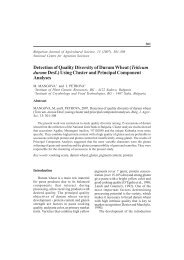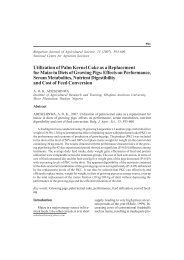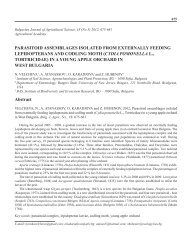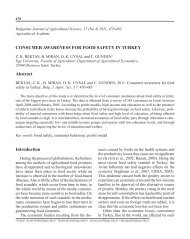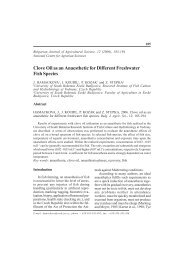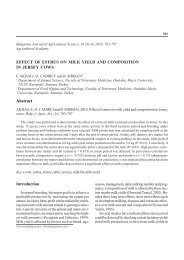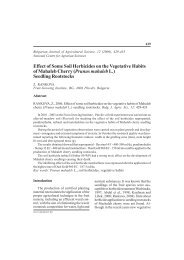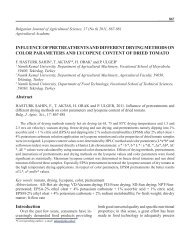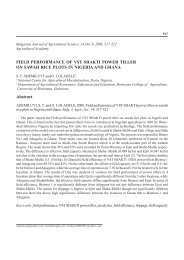EFFECT OF FEEDING FREQUENCIES ON CARP ... - ResearchGate
EFFECT OF FEEDING FREQUENCIES ON CARP ... - ResearchGate
EFFECT OF FEEDING FREQUENCIES ON CARP ... - ResearchGate
Create successful ePaper yourself
Turn your PDF publications into a flip-book with our unique Google optimized e-Paper software.
318 M. Stankovic, Z. Markovic, Z. Dulic, B. Raskovic, I. Zivic and N. Lakical., 2006), the prices present a very important factorin formulating fish diets. However, cheap alternativesto the most expensive fish feed, fishmeal, are found.Soy proteins are the most used substitution for fishmealdue to the high protein content and a similar aminoacid composition, medium price and constant availabilityat the market (Storebakken et al., 2000). Inthe trend of global increase of production in aquaculture,there is a demand for introduction of new componentsin fish diets (Tacon, 2005; Kraugerud, 2008)and their maximal utilization. The diets are also enricheswith feeding stimulants, flavors and emulators.For some species and size categories of fish, anadequately composed diet (Watanabe, 2002;Ruohonen et al., 2004; Bruce et al., 1999) is the mostimportant prerequisite for good growth. However,except the diet composition, very significant differencesin feeding regimes are found (Yamamoto et al.,2007).In the semi intensive system of culturing, the dominanttype of carp production in Serbia, the fish feedmainly consists of row cereals. Nowadays, with gainingknowledge on the quality of compound feeds, producersare substituting cereals with pelleted feed andfurthermore with extruded feed.Since carp are usually cultured in rather big earthenponds, fish are hand fed from the boat once, rarelytwice a day. Aiming to increase the production, a smallgroup of carp producers have installed feeders inearthen ponds that provide food for fish during thewhole day.The aim of this paper was to determine the interdependencebetween the growth rate of carp and differentfeeding frequencies using the same feed.Material and MethodsThe trial was conducted at the Laboratory for fishnutrition of the Faculty of Agriculture, University ofBelgrade and lasted for 60 days. Two year old carp(Cyprinus carpio) used in the experiment were obtainedfrom the fish farm DTD Ribarstvo “Jazovo”.Fish were divided into three groups, with 19 fish pertank having average weight 159.2g. Extruded feedSoprofish 38/12 produced by ’’Veterinarian InstituteSubotica’’ (Serbia) with 4 mm pellets was used forthe experiment.The rearing system consisted of plastic tanks, 120l in volume, with a flow-through system of dechlorinatedwater (flow rate: 0.34 l min -1 in each tank). Oxygenconcentration in tanks was regulated with aeratorsRESUN LP-60.Every tank was equipped with a semi automatedbelt feeder AGK-Technology Gmbh (Germany). Thefirst experimental group of fish had feed available for60 minutes per day. The second group of fish hadfeed available twice a day, for 60 min., with a pauseof 120 min in-between. The third group had continuouslyavailable feed during 12 hours per day. Theamount of given feed in all tanks represented 2.5 %of the ichthyomass. Belt feeders were filled with feedevery day at the same time.Water temperature, oxygen concentration and saturationwere constantly recorded (every 10 min) usingan automatic recorder, Multi-Channel Dissolved OxygenMeter (OxyGuard, Denmark). Electrical conductivityand pH were measured weekly using a field kitMULTI 340i/SET (WTW, Welheim, Germany). Bodyweight and feed were measured using digital balanceKERN plus 2100-2 (accuracy 0.01g).The results were analyzed using descriptive andanalytical statistics. All statistical analyzes were conductedusing statistical package Statistica 6.0. Of statisticalmeasures of center, mean and median wereapplied. The variability of data was quantified usingvariation interval, standard deviation, standard errorand variation coefficient. Furthermore, significant differencesbetween average fish mass were tested. Thehomogeneity of variances was analyzed using Levene’stest and then the parametric model of analysis of variances(ANOVA) and t-test was applied.Results and DiscussionDuring the experiment, oxygen concentration wason average 5.5 mg/l with variations of ±1 mg/l perdays, in every tank, as well as between tanks. Electricalconductivity was in the range from 510 to 514μS




